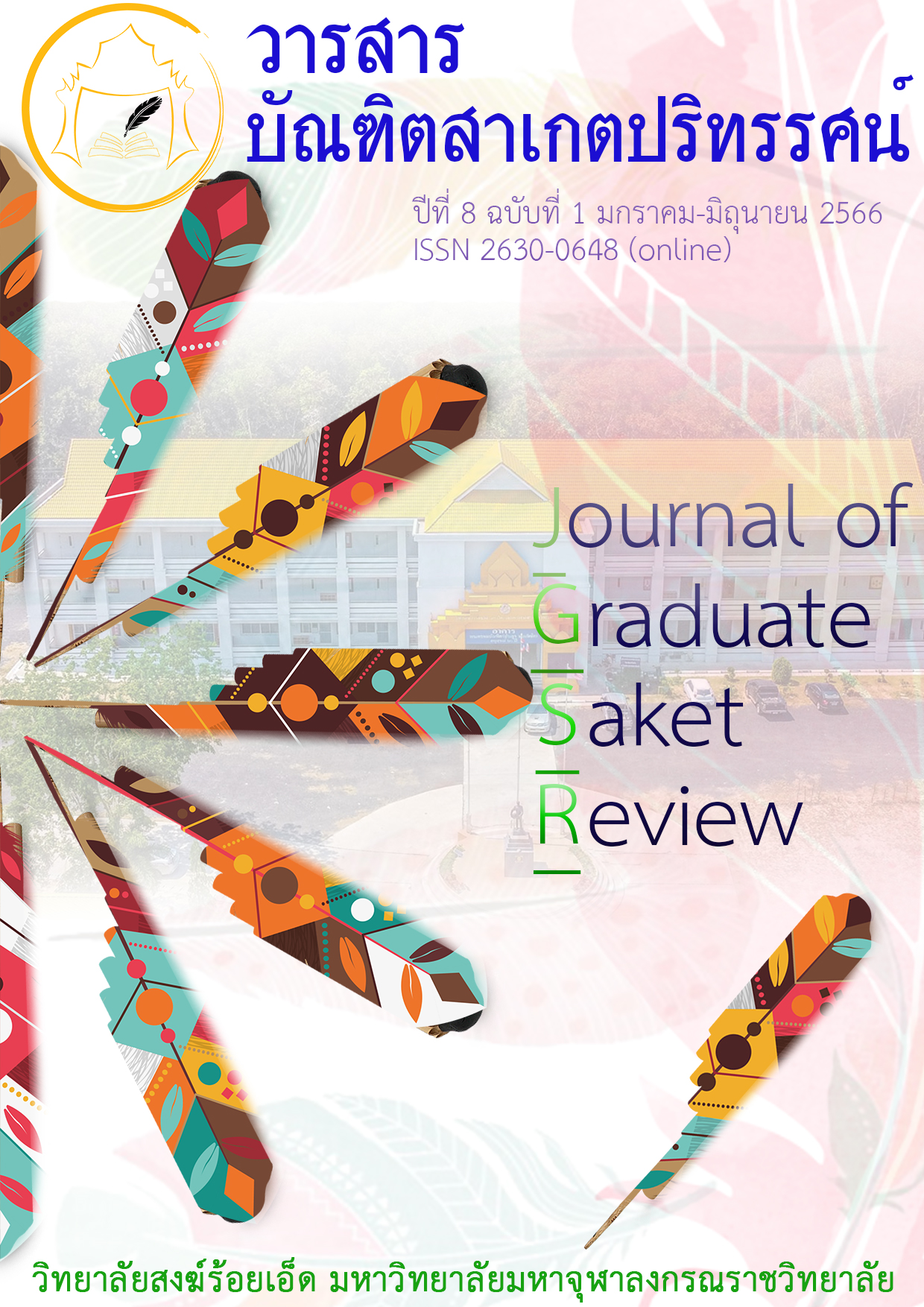Thai language teaching development model to maintain Thai identity to accept the new normal higher education in the 21st century with Buddhist methods
Main Article Content
Abstract
A research on the development of teaching Thai language to maintain Thai identity to accept the new normal in higher education in the 21st century with Buddhist principles research objectives 1) to study the developmental pattern of teaching Thai language to maintain Thai identity in accepting the new normal in tertiary education in the 21st century with Buddhist principles and 2) to examine the consistency of the developmental pattern of teaching Thai language to maintain a Thai identity Being a Thai accepting the new normal in higher education in the 21st century with Buddhist principles The research work uses mixed research methods. during quantitative research and multi-case study research The research was divided into 2 parts: Part 1 was a questionnaire on the level of appropriation of the development model for teaching Thai language to maintain Thai identity for the new normal in higher education in the 21st century and Part 2, a questionnaire on the consistency of the learning management plan in implementing the development model for teaching Thai language, maintaining Thai identity for the new normal in tertiary education in the 21st century with Buddhist methods based on the principles of cross-faith, using the IOC technique. Then select items with an IOC value of 0.50 or more.
Thai language teaching development model to maintain Thai identity to accept the new normal higher education in the 21st century with Buddhist methods. The results of the study and the results of the conformity check from the performance and conformity audit assessment form the origin and importance of the teaching style in terms of the theoretical concepts used as the basis the elements of the teaching style the unit of learning is consistent with the purpose and measurement and evaluation at a high level with a mean of 4.52 and a standard deviation of .491 this research is an outcome-oriented system that focuses on changes in learners’ behavior, thinking, skills and attitudes arising from understanding with the Buddhist method.
Article Details

This work is licensed under a Creative Commons Attribution-NonCommercial-NoDerivatives 4.0 International License.
เนื้อหาและข้อมูลในบทความที่ลงตีพิมพ์ในวารสารบัณฑิตสาเกตปริทรรศน์ ถือเป็นข้อคิดเห็นและความรับผิดชอบของผู้เขียนบทความโดยตรงซึ่งกองบรรณาธิการวารสาร ไม่จำเป็นต้องเห็นด้วย หรือร่วมรับผิดชอบใด ๆบทความ ข้อมูล เนื้อหา รูปภาพ ฯลฯ ที่ได้รับการตีพิมพ์ในวารสารบัณฑิตสาเกตปริทรรศน์ ถือเป็นลิขสิทธิ์ของวารสารบัณฑิตสาเกตปริทรรศน์ หากบุคคลหรือหน่วยงานใดต้องการนำทั้งหมดหรือส่วนหนึ่งส่วนใดไปเผยแพร่ต่อหรือเพื่อกระทำการใด ๆ จะต้องได้รับอนุญาตเป็นลายลักอักษรจากวารสารบัณฑิตสาเกตปริทรรศน์ ก่อนเท่านั้น
References
ภาษาไทย
คณะกรรมการตรวจชำระพระไตรปิฎก. (2538). พระไตรปิฎกภาษาบาลี ฉบับสยามรัฐ. กรุงเทพมหานคร: โรงพิมพ์มหามกุฏราชวิทยาลัย.
ปริวัตร เขื่อนแก้ว และทิพรัตน์ นพฤทธิ์. (2559). การพัฒนารูปแบบการจัดการเรียนรู้ที่สอดคล้องกับผู้เรียนในศตวรรษที่ 21 เพื่อส่งเสริมการคิดเชิงสถิติของนักศึกษาในระดับอุดมศึกษา. หลักสูตรศึกษาศาสตรดุษฎีบัณฑิต สาขาวิชาหลักสูตรและการสอนคณะศึกษาศาสตร์ มหาวิทยาลัยเชียงใหม่.
พระธรรมกิตติวงศ์ (ทองดีสุรเตโช ป.ธ.9, ราชบัณฑิต). (2551). พจนานุกรมเพื่อการศึกษาพุทธศาสนคําวัด. กรุงเทพมหานคร: ธรรมสภาและสถาบันบันลือธรรม.
มหามกุฏราชวิทยาลัย. (2525). พระไตรปิฎกภาษาไทยพร้อมอรรถกถาแปล 91 เล่ม ฉบับมหามกุฏราชวิทยาลัย. กรุงเทพมหานคร: โรงพิมพ์มหามกุฏราชวิทยาลัย.
ภาษาอังกฤษ
Mahamakut Buddhist University. (1982). Tipitaka in Thai language and commentary translated 91 volumes, Mahamakut Buddhist College Edition. Bangkok: Mahamakut Buddhist University Printing House.
Pariwat Khueankaew and Tiparat Nopharit). (2016). Development of a learning management model that is consistent with learners in 21st century to promote statistical thinking among students in higher education. Doctor of Education Program Department of Curriculum and Instruction, Faculty of Education Chiang Mai University.
Phra Thammakittiwong (Thongdee Suratecho Phor.Tor.9, Royal Graduate School). (2008). A Dictionary for the Study of Buddhist Words. Bangkok: Dhammasapa and Banlue Dhamma Institute.
Tripitaka Audit Committee. (1995). The Pali Tipitaka, Siam Rath edition. Bangkok: Mahamakut Buddhist University Printing House.


